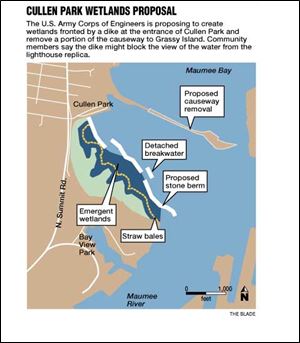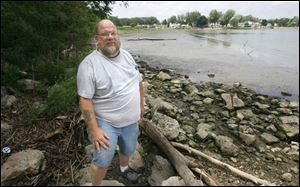
Cullen Park group opposed to Corps of Engineers plans
7/26/2010
Point Place resident Hunter Kornowa rides his bike on the causeway, which would lose 2,000 feet under the proposal from the Army Corps of Engineers.
The Blade/Amy E. Voigt
Buy This Image
 Cullen Park Wetlands proposal July 26, 2010" rel="storyimage1" title="Cullen-Park-group-opposed-to-Corps-of-Engineers-plans.jpg"/>
Cullen Park Wetlands proposal July 26, 2010" rel="storyimage1" title="Cullen-Park-group-opposed-to-Corps-of-Engineers-plans.jpg"/>
<img src=http://www.toledoblade.com/assets/jpg/TO66067417.JPG> <b><font color=red>VIEW:</b></font color=red> <a href="/assets/pdf/TO73051726.PDF" target="_blank "><b>Cullen Park Wetlands proposal</b></a> July 26, 2010
Behind the small lighthouse replica marking the entrance to Cullen Park in Point Place are weeds several feet high, blocking the view of a scenic bay.
A community group, Visions for Cullen Park, is trying to persuade the city to get rid of the weeds and extend the adjacent pedestrian pathway to boost the park's tourism appeal, group founder Vee Stader said.
But she said the effort might be negated if the U.S. Army Corps of Engineers chooses Cullen Park's entrance on Summit Street as the site to create a wetlands fronted by a 12-foot dike. Though this would provide new habitats for plant and animal species, some Point Place residents say it would also deter people from visiting the area and therefore harm Toledo's economy.
Visions for Cullen Park first met in March, and members, including many from the Point Place Business Association, traded ideas about how to improve the park to draw tourists to Point Place, Ms. Stader said.

Gene Kidd of the group Visions for Point Place stands on a causeway that links the park to Grassy Island.
"[Point Place] is a peninsula. The waterways come together at this point, hence the name, as I understand it," she said. "It's untapped for what it could be."
People come from as far as Wisconsin to use the two public boat-launch ramps next to the parking lot, and the number of visitors could be amplified with major renovations, group member Chuck Conner said.
The group also discussed renovating a causeway in the park that leads to Grassy Island to make it easier for people to make the trip on foot.
A month later, they were informed of the proposal for the wetlands, and redirected some of their efforts to preventing it.

Point Place resident Hunter Kornowa rides his bike on the causeway, which would lose 2,000 feet under the proposal from the Army Corps of Engineers.
The Army Corps of Engineers, whose Buffalo district office oversees Ohio, is considering Cullen Park as one of a dozen possible sites for a wetlands to be created from the 850,000 cubic yards of fine sediment dredged annually from the Maumee River and Bay, project manager Craig Forgette said.
Congress demands that the Army Corps dredge the water bodies to keep the federal navigation channels clear for trade, he explained.
Wetlands are ecologically beneficial and have been greatly diminished on the coast of the Great Lakes, said Jay Miller, a Corps biologist.
The dike would keep the sediment in and slow down water flow, allowing plants to establish themselves on shore without being washed away, he said.
The Corps also wants to remove about 2,000 feet of the causeway that leads to Grassy Island.
The project could cost between $5 million and $200 million, depending on location and other factors, and is only in preliminary planning stages.
Sixty-five percent of the funding would come from a federal source, and the Corps has to find a nonfederal sponsor for the rest of the funding, Mr. Forgette said.
Mr. Forgette and Mr. Miller met with 240 community members June 29 to explain what they wanted to do with the land.
Though some supported taking out the causeway, few were happy about the wetlands project.
"There was a lot of concern about what could be seen from the lighthouse and the future use of the project," Mr. Forgette said.
Gene Kidd, chairman of Visions for Cullen Park, said the Corps is just looking for the easiest way to dispose of its waste.
Though there are other options on the table, Cullen Park would be the cheapest because the water is easily accessible, he said.
But Mr. Miller said there are not currently estimates available for each of the options, and he was unsure which was the cheapest.
Ms. Stader said she understands it is a good idea, but would just like it somewhere else, including other places further into Cullen Park.
"There are better places than this for wetlands," she said.
"It would be marshy and weedy. I feel it would totally destroy our vision."
Mr. Forgette and Mr. Miller will make plans to meet with community members again, possibly in September, to show them artistic renderings of the project and review the alternatives.
Contact Aliyya Swaby at:
aswaby@theblade.com or
419-724-6050